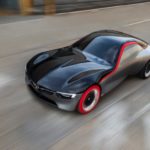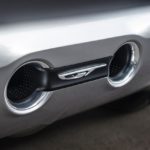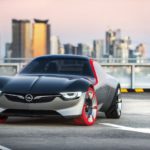Archives for :
January2016
The Opel GT Concept will be unveiled to the World at the 86th Geneva International Motor Show (March 3 to 13, 2016). The GT Concept is a front mid-engine and rear-wheel drive is a direct descendant of the Opel GT and the Monza Concept and evolves Opel’s sculptural design philosophy. The car is very simplified and pure in form. The GT Concept has no door handles or exterior door mirrors.
“We are taking the next step towards even more emotion and driving pleasure with the Opel GT Concept. The GT Concept shows what Opel stands for now. We are confident, ambitious, innovative and we want win over more customers with every new car,†said Opel Group CEO Dr. Karl-Thomas Neumann who is already looking forward to the world premiere in Geneva.
- Avant-garde: The Opel Motoclub 500 motorbike from 1928.
The Opel GT Concept will follow in the footsteps of the famous Opel Experimental GT at the Geneva Motor Show. In 1965, only one year after the foundation of the first design studio run by a European car manufacturer, Opel presented this sleek and expressive coupé based on the technology of the Kadett B at the Frankfurt Motor Show. The GT incorporated innovations such as retracting headlamps and displayed a slim form along with perfect proportions without unnecessary decoration. The uncompromising concept by Erhard Schnell mainly wanted to be one thing – a design statement. The reactions from the public were so overwhelming that the series production Opel GT was at dealerships only three years later. The rest is history – a success story, an automotive icon.
The GT Concept incorporates a red signature line that splits the vehicle body horizontally. The distinctive red front tires – mounted on rims with a roller skate design – are reminiscent of the Opel motorbike Motoclub 500 that was also avant-garde at its time and was the proud owner of two red tires in 1928. Apart from that, the GT Concept does not have many links to the past. The long bonnet, the absence of a trunk lid, the central dual exhaust and of course, the name all refer to the original GT. Apart from that the Opel GT Concept is independent with no sign of retro-design.
“We created the GT Concept to capture the bold, emotional spirit of the Opel brand. It is dramatic, sculptural and full of innovations, which is our great tradition that we intend to continue. Back in 1965, Opel developed the Experimental GT, a thoroughly modern vehicle that also boasted a pure sculptural shape. It’s certainly difficult to reinvent an icon but just as the Experimental GT was avant-garde back then, so too is this GT Concept today – absolutely pure, minimalistic, yet bold and uncompromising. This coupé impressively demonstrates the continuous development of our Design philosophy – ‘Sculptural Artistry meets German precision’,†said Mark Adams, Vice President, Design Europe.
A key innovation of the Opel GT Concept are the large doors with the integrated side windows that show a seamless transition from glass to painted surfaces. Both the driver and the front passenger gain access to the unexpectedly spacious interior after pressing the touchpad for the electric doors that is integrated in the red signature line of the roof. Even tall drivers have enough room inside. The doors immerse considerably into the front wheel arches when opened. This space-saving and patented mounting allows a large opening angle – particularly in relatively tight parking spaces. The compact athlete is therefore optimized especially for urban areas. Two cameras mounted behind the wheel arches ensure a safe overview while driving in the city. They transmit their images to two monitors on the left and right-hand side of the cockpit – the days of exterior door mirrors and blind spots are therefore over. The windshield flows into a glass panorama roof enabling the occupants to enjoy a driving experience similar to that offered by a targa with a removable roof.
Power
The stretched bonnet reveals the powertrain concept of the GT Concept: Just like the first Opel GT and Corvette, also made by GM, it has a front mid-engine. The vehicle’s centre of gravity is therefore low and central – ideal for sporty handling and excellent cornering dynamics. The Opel GT Concept has a powerful 1.0-litre, three-cylinder turbocharged engine based on the ultra-modern all-aluminium engine used in ADAM, Corsa and Astra. The extremely efficient direct injection petrol unit develops 107 kW/145 hp and maximum torque of 205 Nm in its sporty trim (consumption values for the Opel GT Concept are not available yet). The turbo power is sent towards the rear axle with mechanical differential lock via a sequential six-speed transmission that is operated by shift paddles on the steering wheel. The low weight (below 1,000kg) allows the GT to accelerate from 0 to 100 km/h in less than eight seconds, with a top speed of 215 km/h.
A further highlight of the Opel GT Concept are the main headlamps with integrated indicators. Thanks to projection technology, these shine very three-dimensionally. The next generation adaptive full LED light is obviously the perfect match for this technology. The Opel IntelliLux LED® matrix light, which allows glare-free high beam driving, already made its debut in the new Astra in 2015 and won the SAFETYBEST Award. The Opel GT Concept sees the introduction of the next stage of development of the intelligent light system. The design of the lights is rounded off by the three-dimensional design of the tail lamps that make the new GT distinctive at night.
At Ford, ensuring materials and upholstery are up to the mark is crucial for everything from the first impression all the way down the line to the perception of the vehicle after considerable use – and thus resale value and reputation. We knew about Ikea’s kitchen drawer tests, now Ford are shedding a little light on their processes for testing and selecting fabrics and materials.
In short..
- Ford engineers scratch, snag and stretch all the different materials that go inside a vehicle to help ensure their durability and suitability to long-term customer use
- Fabrics that are used inside Ford vehicles are stained with everyday substances like hot coffee, soda and dirt to evaluate how well they can be cleaned afterward, testing their overall stain resistance
- A team of examiners smell various samples of materials used inside Ford vehicles and rank them to help the engineers achieve interiors with a perceptible but not disturbing odour
- Soiling and Cleanability Test — putting Ford’s interior materials to the ultimate stain test to help ensure accidental spills and smudges don’t ruin the car’s interior in the long run.
- Odor Test – All materials, leather or fabric used in Ford vehicles are put through this meticulous sniff test to help the engineers achieve interiors with a perceptible but not disturbing smell
- Five Finger Scratch Test – scratching samples of different plastics to see how strong, sturdy and as resilient are they to scratches
- Resistance to Dye Transfer Test – rubbing materials of different colors against the leather used for car seats to see if any stains are left behind.
- Mace Snagging Test – spinning seat fabrics on rotating rollers by spikey iron ball to test their strength.
- Soiling and Cleanability Test — splashing different substances on seat fabrics to evaluate how well they can be cleaned afterwards, testing their overall stain resistance
Throughout a vehicle’s lifetime, it’s inevitable that the materials inside a car show signs of wear and tear. Wear occurs in all contact areas from sitting on car seats, leaning on arm rests, gripping the steering wheel through to fiddling with the instruments.
So what does Ford do to ensure interiors will hold up?
To help guarantee the durability of these fabrics, leathers and plastics, Ford engineers subject every material used inside Ford vehicles to a series of meticulous and unrelenting tests where they are stretched, scratched, snagged, sniffed and even splashed with the likes of grease, dirt and hot coffee, to see how they will stand up against the test of time.
These tests are done to help ensure it takes a lot more than a spilled cup of coffee, the graze of a sharp edge or any accidental scrapes and scuffs to break down these materials. Some of the unusual ordeals Ford materials need to go through include:
- The Five-Finger Scratch Test, which is used to scratch samples of different plastics to see how much abuse they can take
- The Soil and ‘Cleanability’ Test, which splashes different substances on seat fabrics to evaluate how well they can be cleaned afterwards, testing their overall stain resistance
- The Resistance to Dye Transfer Test, which rubs materials of different colors (i.e. those dreaded new blue jeans, long-term destroyer of white leather sofas around the world) against the leather used for car seats to see if any stains are left behind
- The Mace Snagging Test, which spins seat fabrics on rotating rollers roughly 600 times while they’re repeatedly struck by a spikey iron ball to test how strong they are
In addition to the poking, prodding and scratching, a team of examiners smell various samples of materials used inside Ford vehicles and rank them to help the engineers achieve interiors that are free of disturbing odours.
The purpose of these tests is to create and maintain a level of quality in Ford vehicles that can be expected to last through the vast majority of scenarios of car usage for years to come.
Further watching..
Nissan put an exclamation point on the start of sales of its all-new 2016 TITAN XD by unveiling a super-sized, off-road modified design study it calls the TITAN Warrior Concept. Nissan Design America (NDA) took the TITAN XD’s production design to new extremes with unapologetic, aggressive, athletic styling features that declare the concept’s off-road adventure intent and Nissan’s optimism for the truck market.
“Truck buyers have a seemingly insatiable appetite for more content and more unique offerings,†said José Muñoz, executive vice president, Nissan Motor Co., Ltd. and chairman, Nissan North America, Inc. “Even though our all-new 2016 TITAN XD just started arriving at Nissan dealers nationwide last month, we are already exploring new territory where TITAN might go in the future.â€
Pushing the Boundaries
Just as the all-new TITAN XD with its Cummins® 5.0L V8 Turbo Diesel engine has bulked up the standards for customers shopping the light-duty pickup class, the TITAN Warrior Concept was created to take the production version to the extreme.
“Nissan has always pushed the boundaries of traditional automotive design and engineering, from our Nissan GT-R supercar to the new TITAN XD,†explained Muñoz. “We do this with a clear conviction that there are buyers out there who appreciate something everyone else does not have. A `work hard, play harder, get bigger’ TITAN XD certainly does the job.â€
The TITAN Warrior Concept builds on the recent Project Titan, a crowd-sourced customization of an original-generation Titan that sent two U.S. military veterans representing Wounded Warrior Project® on a once-in-a-lifetime adventure in Alaska. The new concept truck also pays homage to Nissan’s heritage of off-road racing and adventuring, which goes back to the days of Baja “Hardbody†competition pickups and Paris-Dakar Rally treks.
“As we launch the all-new 2016 TITAN XD, the TITAN Warrior Concept was conceived to share our team’s pride and excitement to be back in the truck market in a big way,†added Muñoz. “The team delivered.â€
A Warrior with a “Modern Armor†Exterior
The TITAN Warrior Concept creators had more than a strong foundation on which to build their vision of a bold and expanding future in the full-size pickup market, they had a familiar one.
As part of the group that brought the “American TITAN†to life – a group that ranged from Tennessee, Michigan, Mississippi, Indiana, Arizona and California – the design team imagined how their original TITAN design, inspired by warriors in ancient Greek mythology, might evolve to extreme levels of adventure duty.
First, while maintaining the TITAN XD Crew Cab’s standard wheelbase and length, they wanted to give the concept truck an even more powerful presence than the original. The height was raised nearly three inches, from 78.7 inches to 81.5 inches, to fit a quartet of 37-inch tall off-road tires mounted on custom 18×9.5-inch aluminum-alloy wheels. The wheels’ machined aluminum surfaces feature a dark matte finish and continue the production TITAN XD’s “precision tool†design theme.
To create clearance for the new oversize tires and accommodate the new, long-travel suspension, the TITAN Warrior Concept’s width was extended three inches on each side, from 80.6 inches total to 86.6 inches. Once the dimensions and imposing stance were mapped out, the extreme makeover began in earnest.
Building on the new second-generation TITAN’s warrior-inspired styling, the designers amplified the protective look of the production exterior. Designating the new look as “modern armor†– with a stealthy, robotic quality – they continued the anatomical feel of the production TITAN, but added a more machine-like, sharper-edge appearance.
The grille and signature TITAN headlights were enhanced to offer a more technical, menacing look. The front and rear fenders have been flared and offer an extremely muscular appearance. Functional hood vents were added for cooling the powerful diesel engine. The broad hoodline is balanced underneath by the large front skidplate, which interlocks into the powerful front bumper.
Custom LED lights, front and rear, add to the TITAN Warrior Concept’s stealthy presence. The headlights carry a sense of the new Nissan signature boomerang lights, but with a more precise, upright, robotic feel. In the rear, the integrated LED taillights take the form of a TITAN “T†logo, split by the wide tailgate. As a finishing touch, a quad-tipped exhaust system is integrated into the rear bumper.
Despite its massive bulk, TITAN Warrior Concept adds several aerodynamic elements, including carbon fiber rear cab spoiler and tailgate spoilers. Additional unique body elements include integrated, roof-mounted LED off-road lights.
The TITAN Warrior Concept is covered in a custom matte-gunmetal paint called “Thunder†and accented in special “Magma†orange and black color highlights.
“There’s a sense to the exterior design that the TITAN Warrior Concept could drive right off the auto show stage and retrace the historic route of Nissan’s off-road racing victories in the Baja Peninsula,†said Muñoz. “And given the high-torque Cummins 5.0L V8 Turbo Diesel, extensive suspension modifications and TITAN XD heavy-duty durability, it certainly could.â€
A Polished, Premium Sport Interior
Inside the TITAN Warrior Concept’s rugged performance-focused exterior is an interior conceived to handle the abuse experienced on an extended off-road excursion in comfort and style.
“Today’s truck enthusiasts don’t just use their trucks for weekend adventures, they do double-duty as daily drivers,†explained Muñoz. “Therefore the TITAN Warrior Concept’s interior reflects a premium outdoor lifestyle, closer in look and content to a new TITAN XD Platinum Reserve model than a stripped-down pre-runner.â€
The interior design team at Nissan Design America wanted to give the vehicle a unique polished “chronograph†look and feel, focusing on materials and detailing while remaining true to the TITAN Warrior Concept’s active performance theme. For example, the seats are covered in a carbon-colored high-strength seat fabric trimmed with “Magma†orange accents. Interior surfaces utilize material, such as carbon fiber, polished chrome finishes, leather with accented Magma orange stitching.
The TITAN Warrior Concept’s steering wheel is custom-built, continuing the technical adventure theme, milled from one block of aluminum. Other interior details include unique hot-and-cold drink containers integrated into the center console. Robust auxiliary toggle switches are integrated into the center stack for additional off-road accessories. Instrument panel-mounted auxiliary gauges are provided to easily monitor truck performance.
Performance Unleashed
As an extreme adventure version of the new 2016 TITAN XD, the TITAN Warrior Concept utilizes the factory fully boxed ladder frame and Cummins® 5.0L V8 Turbo Diesel engine and the standard heavy-duty 6-speed Aisin automatic transmission as its base.
Where the TITAN Warrior Concept departs from its production counterpart is in the full custom suspension design. In the front, the standard suspension has been replaced with custom upper and lower control arm with performance ball joints, along with racing-style internal bypass reservoir coil-over shocks with custom reservoir mounts and tie-rod extensions.
In the rear, the modifications include custom internal bypass reservoir shocks with custom reservoir mounts. Adjusted-length prototype axles were installed, along with a custom sway bar, relocated sway bar brackets and rear lift blocks and U-bolts. Hydraulic pressurized bump stops were also added front and rear.
Exploring New Boundaries
The debut of the TITAN Warrior Concept at the North American International Auto Show comes exactly one year since the debut of the production TITAN XD on the same stage. TITAN XD has been named “Truck of Texas†by the Texas Auto Writers Association (TAWA) in their annual Texas Truck Rodeo, which puts the industry’s best trucks, SUVs and CUVs through a grueling two-day evaluation. In addition to the competition’s top award, Truck of Texas, the TITAN XD won three other honors – Luxury Pickup Truck of Texas, Off-Road Pickup Truck of Texas and Best Powertrain for its standard Cummins® 5.0L V8 Turbo Diesel engine.
Now that TITAN XD Crew Cab with a Cummins 5.0L V8 Turbo Diesel engine is in Nissan showrooms, the rollout of new models continues. In December, Nissan announced that advanced gas-powered Endurance® V8 producing 390 horsepower and 401 lb-ft of torque will be available in both TITAN and TITAN XD models beginning in early spring 2016.
Ultimately, the new TITAN will be offered in three cab configurations, two frame sizes, three powertrain offerings and five grade levels (more information on the full lineup will be available at a later date).
“While Nissan still has many roads and trails to travel as we continue to launch additional production versions of our bold new TITAN, this new TITAN Warrior Concept gives an important signal to American truck enthusiasts that our vision for exploring new boundaries remains strong,†concluded Muñoz. “Truck lovers are never static and neither is TITAN.â€













